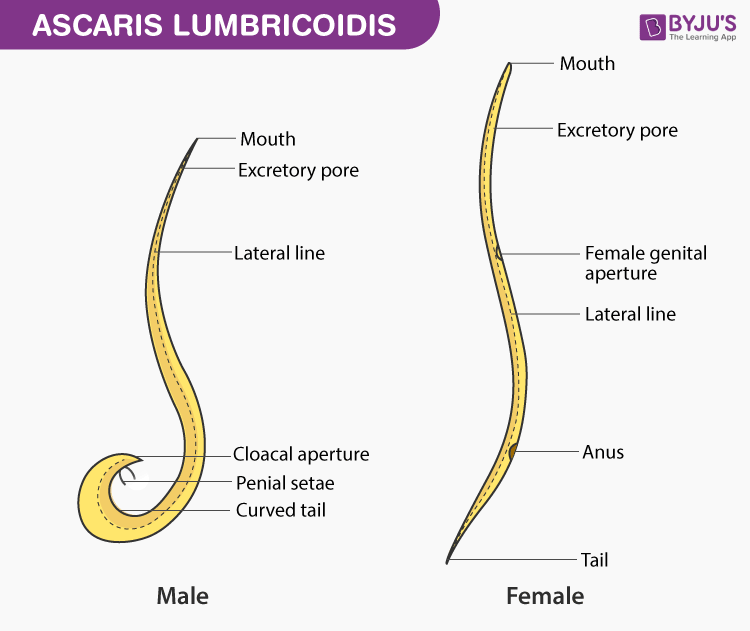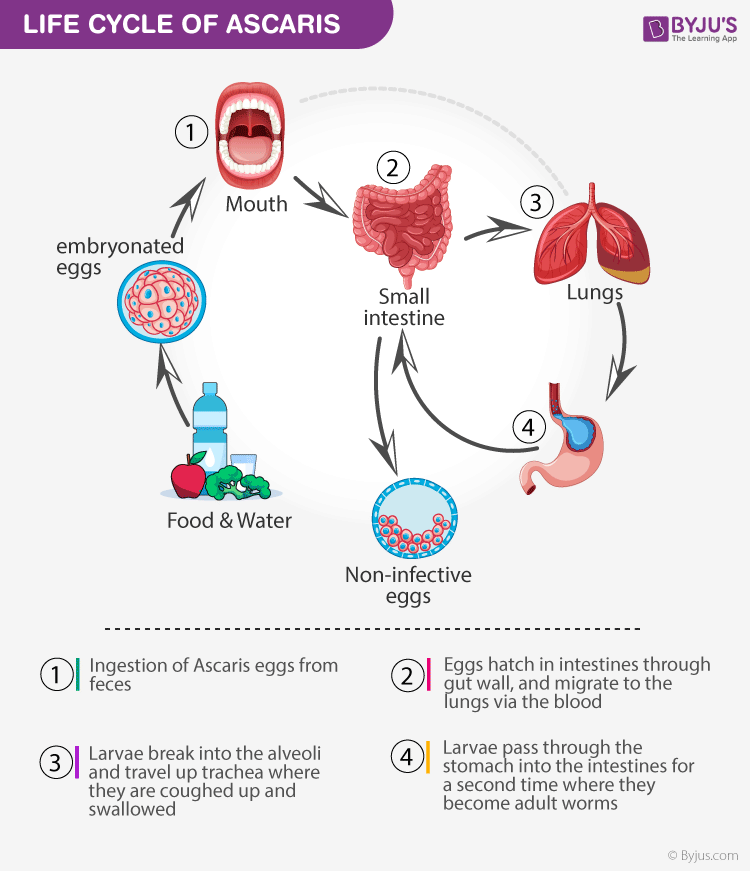Ascaris lumbricoides is a nematode roundworm that resides like parasites in a human being’s small intestine. These worms fall under the family Ascarididae, the class Secernentea and the order Oxyurida. These worms are prominently found in pigs. They are large roundworms that measure up to 40 cm long, surrounded by a mouth with three lips. Ascaris roundworms cause an infection called Ascariasis found in the small intestine. This infection has no symptoms but heavy infestation in children can lead to digestive issues, malnutrition and growth stunting. Ascariasis is a disease that has affected around 807 million to 1.2 billion people worldwide.
Let us learn the structure and life cycle of Ascaris lumbricoides with the help of a neat labelled diagram.
Ascaris StructureLife Cycle of AscarisFrequently Asked Questions
Ascaris Structure
Ascaris comes under the phylum Aschelminthes. They are commonly called roundworms. They are bilaterally symmetrical and have a pseudocoelom. Sexes are separate, female Ascaris are longer than males. The alimentary canal is well developed with a muscular pharynx. Waste products are excreted out through an excretory pore.
Male and Female Ascaris – Image

Also Check: Ascaris (Male and Female) diagram page for more information. Let’s further look at the life cycle of Ascaris lumbricoides with a neat and labelled diagram to get a better understanding.
Ascaris Life Cycle

1) The Egg – Stage 1 –
The adult Ascaris worms live inside the walls of the small intestine in human beings. The female worm grows up to 35 cm in length and lays approximately 20,000 eggs that are passed out of the human stool into the environment. Unfertilized eggs are ingested but are not infective but fertilized eggs are infective and undergo further development in the next stage.
2) The Larvae – Stage – 2 –
The fertilized eggs grow into a larva. The larva then becomes infective after 18 days to several weeks, depending on the environmental conditions like warmth, moist, and soil region. After ingestion, the fertilized eggs hatch and larvae emerge and invade the intestinal mucosa. From here they transport to other parts like lungs. Then they make their way to the throat so that the worms can be swallowed and returned to the intestines so as to reach maturity.
3) The Adult – Stage 3 –
When the larvae reach the small intestine, they develop into adult worms. At this stage, the adult worm produces a large number of eggs. Around 2 to 3 months are necessary from ingestion of infective eggs to oviposition by female adult worms. Adult ascaris worms are able to live for about 1 to 2 years.
Conclusion:
Human beings are infected by these worms when they consume food or water that is contaminated by Ascaris worm eggs. Human beings and swines are primary hosts for Ascaris. Other common hosts for Ascaris include monkeys, dogs etc.
To explore more information on Ascaris and other worms, register with BYJU’S Biology.
Frequently Asked Questions
How to get rid of Ascaris worms?
By taking medications like albendazole and mebendazole, one can remove the Ascaris roundworm, regardless of the species.
How does Ascaris enter the human body?
Ascaris infection (Ascariasis) is caused when contaminated food or water is consumed. The contaminated food or water contains eggs that hatch in the intestines, attach to the wall, and shift to the lungs via blood.
How long does the infection Ascaris last in humans?
An adult Ascaris worm can live up to 1 to 2 years.
What do Ascaris feed on?
Ascaris worms feed on the food that their hosts eat, but heavy infections can lead tangle of worms that obstruct the gut.

Comments